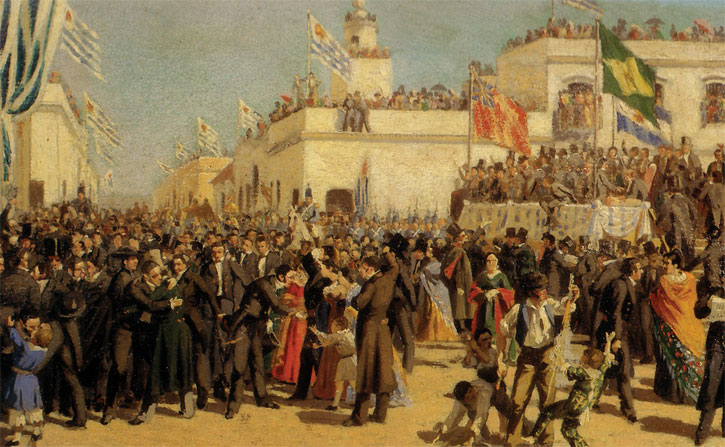Constitution of Uruguay of 1830 on:
[Wikipedia]
[Google]
[Amazon]
 The first
The first
Text of the Constitution of 1830
{{in lang, es 1830 1830 documents 1830 establishments in Uruguay 1830 in politics 1830 in law July 1830 events
 The first
The first Constitution of Uruguay
The Constitution of Uruguay () is the supreme law of Uruguay. Its first version was written in 1830 and its last amendment was made in 2004.
Uruguay's first constitution was adopted in 1830, following the conclusion of the three-year-long Cispla ...
dates back to 1830. Drafted by the Constituent Assembly, summoned in the Church of La Aguada in 1829, it was sworn by the citizens on 18 July 1830.
This political constitution was in force until 1918, when it was replaced by a new constitutional text.
Overview
The 1830 constitution has been regarded as Uruguay's most technically perfect charter. Heavily influenced by the thinking of the French and American revolutions, it divided the government among the executive, legislative, andjudicial
The judiciary (also known as the judicial system, judicature, judicial branch, judiciative branch, and court or judiciary system) is the system of courts that adjudicates legal disputes/disagreements and interprets, defends, and applies the law ...
powers and established Uruguay as a unitary republic with a centralized form of government. The bicameral General Assembly was empowered to elect a president with considerable powers to head the executive branch for a four-year term. The president was given control over all of his ministers of government and was empowered to make decisions with the agreement of at least one of the three ministers recognized by the 1830 constitution.
Like all of Uruguay's charters since then, the 1830 constitution provided for a General Assembly composed of a Chamber of Senators (''Cámara de Senadores''), or Senate (''Senado''), elected nationally, and a Chamber of Representatives (''Cámara de Representantes''), elected from the departments. Members of the General Assembly were empowered to pass laws but lacked the authority to dismiss the president or his ministers or to issue votes of no confidence
A motion of no confidence, also variously called a vote of no confidence, no-confidence motion, motion of confidence, or vote of confidence, is a statement or vote about whether a person in a position of responsibility like in government or mana ...
. An 1834 amendment, however, provided for ''juicio político'', or impeachment, of the ministers for "unacceptable conduct".
As established by the 1830 constitution, the Supreme Court of Justice, and lesser courts, exercised the judicial power. The General Assembly appointed the members of the high court. The latter – with the consent of the Senate in the case of the appellate courts – appointed the members of the lesser courts. The constitution also divided the country into departments, each headed by a governor
A governor is an administrative leader and head of a polity or political region, ranking under the head of state and in some cases, such as governors-general, as the head of state's official representative. Depending on the type of political ...
appointed by the president and each having an advisory body called a Neighbors' Council (''Consejo de Vecinos'').
Although the 1830 constitution remained nominally in effect for eighty-seven years, it was actually too rigid to replace or modify. Successive ''de facto
''De facto'' ( ; , "in fact") describes practices that exist in reality, whether or not they are officially recognized by laws or other formal norms. It is commonly used to refer to what happens in practice, in contrast with ''de jure'' ("by la ...
'' governments violated it repeatedly. In the 1878–90 period, the Blancos and Colorados, helped also by the Constitutional Party, initiated the framework for a more stable system through understandings called "pacts between the parties." This governing principle, called coparticipation (''coparticipación''), meaning the sharing of formal political and informal bureaucratic
The term bureaucracy () refers to a body of non-elected governing officials as well as to an administrative policy-making group. Historically, a bureaucracy was a government administration managed by departments staffed with non-elected offi ...
power, has been formally practiced since 1872.
Memorials
* The anniversary of the 1830 promulgation of this original constitution on July 18 is a public holiday in Uruguay. * Many squares in Uruguay bear the name of the Constitution, notably the Constitution Square in Montevideo. * Many streets in different cities of Uruguay are named after the date of the First Constitutional Oath, notably 18 de Julio Avenue in Montevideo. * The Centennial of 1830 was an occasion to celebrate a century of constitutional life; the Estadio Centenario was named after that anniversary. * Also in the framework of the Centennial, the Obelisk of Montevideo was erected as a memorial to the First Constitution.Bibliography
* *See also
*Treaty of Montevideo (1828)
The Preliminary Peace Convention was a bilateral treaty signed on 27 August 1828 between the Empire of Brazil and the United Provinces of the Río de la Plata, after British mediation, that put an end to the Cisplatine War and recognized the in ...
* Constitution of Uruguay
The Constitution of Uruguay () is the supreme law of Uruguay. Its first version was written in 1830 and its last amendment was made in 2004.
Uruguay's first constitution was adopted in 1830, following the conclusion of the three-year-long Cispla ...
References
External links
Text of the Constitution of 1830
{{in lang, es 1830 1830 documents 1830 establishments in Uruguay 1830 in politics 1830 in law July 1830 events